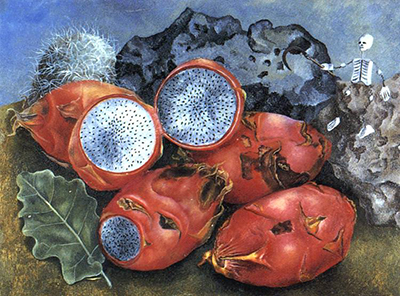Furthermore, the fruit is one of the rare audible fruits available in the desert and has a black seed. Pitahayas was a favorite of the artist prompting him to make a realistic painting of his best fruit in 1938. The pitahayas painting that was done by Frida are more realistic. Moreover, the artist gives a representation of the environment where they survive best. He does this by including rocks at the base of the paint and using a round shaped cactus on the background.
At the background of the painting, we can see a small skeleton with a scythe at hand. Because of this, we can tell that the picture was done during a holiday. The skeleton is a symbol of the holiday of the dead, a two-day holiday that commences on November 1st. Furthermore, the artist displays great mastery of curves by displaying perfectly cut pitahayas. Kahlo goes on further to show what a sliced pitahaya should look like.
The artist portrays a professional use of his brush. The painting can stand out and capture the attention of its audience despite being lifeless. Furthermore, a mere glimpse at the portrait attracts the attention of the audience making the wonder what the painting is. The piece takes most individuals time to figure out what is on display, as even professionals take time to establish what it is.
The definition of an artist is an individual who seeks to bring in life to that that is lifeless. Life is something hard to understand. Furthermore, the most challenging part of being an artist is the act of giving out life. Moreover, numerous paintings have been a failure within the centuries due to lack of life. However, many pictures have strived over the century and are a success because they exhibit life in them. Furthermore, most paintings never feature living beings but instead have objects that seem to be alive. One such art that brings life to the nonliving is the Pitahayas by Frida Kahlo. Read on to discover more about the painting.

